Machining Distortion Minimization of Monolithic Aircraft Parts Based on the Energy Principle
Abstract
:1. Introduction
2. Machining Distortion Analysis
2.1. Energy Principle of Machining Distortion
2.2. A Rapid Prediction Model of Machining Distortion for Beam Parts
3. Case Study
3.1. The Part Geometry
3.2. Initial Residual Stress Measurement
3.3. Simulation and Experiment Design
4. The Machining Distortion Results
5. Machining Distortion Minimization
5.1. The Relationship between Bending Energy and Final Distortion
5.2. Influence of the Fluctuant Initial Residual Stress on Part Distortion
5.3. Influence of the Part Geometry on Part Distortion
5.4. Influence of the Part Location on Part Distortion
6. Conclusions
- (1)
- During the machining process, the release of initial strain energy leads to machining distortion. The bending energy corresponds to the bending distortion. For all the cases in this study, the proportion of bending strain energy to total strain energy is always maintained at a low level, and the maximum proportion is no more than 52%. Therefore, it is more accurate to use bending strain energy to characterize the distortion potential of beam parts.
- (2)
- A rapid distortion prediction model based on equivalent initial residual stress was proposed. FE simulations and experiments verified the accuracy of this analytical model. The maximum relative error between the experimental and calculated results is no more than 26.5%.
- (3)
- The fluctuant initial residual stress, the part geometry and the part location affect the initial energy contained in the part, and then affect the expected final part distortion. The maximum distortion difference of 20 mm blanks was 0.34 mm, and the maximum difference of 30 mm blanks was −0.08 mm. By reducing the initial residual stress fluctuation, improving the symmetry of the part geometry and adjusting the position of the part in the blank, the expected part distortion can be minimized.
Author Contributions
Funding
Conflicts of Interest
References
- El-Aty, A.A.; Xu, Y.; Guo, X.; Zhang, S.-H.; Ma, Y.; Chen, D. Strengthening mechanisms, deformation behavior, and anisotropic mechanical properties of Al-Li alloys: A review. J. Adv. Res. 2018, 10, 49–67. [Google Scholar] [CrossRef] [PubMed]
- Li, W.; Ma, L.; Wan, M.; Peng, J.; Meng, B. Modeling and simulation of machining distortion of pre-bent aluminum alloy plate. J. Mater. Process. Technol. 2018, 258, 189–199. [Google Scholar] [CrossRef]
- Li, X.; Li, L.; Yang, Y.; Zhao, G.; He, N.; Ding, X.; Shi, Y.; Fan, L.; Lan, H.; Jamil, M. Machining deformation of single-sided component based on finishing allowance optimization. Chin. J. Aeronaut. 2020, 33, 2434–2444. [Google Scholar] [CrossRef]
- Gao, H.; Zhang, Y.; Wu, Q.; Song, J. An analytical model for predicting the machining deformation of a plate blank considers biaxial initial residual stresses. Int. J. Adv. Manuf. Technol. 2017, 93, 1473–1486. [Google Scholar] [CrossRef]
- Yang, Y.; Li, X.; Li, L.; He, N.; Zhao, G.; Chen, N.; Lan, H.; Zhou, Z. Investigation on deformation of single-sided stringer parts based on fluctuant initial residual stress. J. Mater. Process. Technol. 2019, 271, 623–633. [Google Scholar] [CrossRef]
- Huang, X. Mathematical Modeling of Aeronautical Monolithic Component Machining Distortion Based on Stiffness and Residual Stress Evolvement. Chin. J. Mech. Eng. 2017, 53, 201–208. [Google Scholar] [CrossRef]
- Richter-Trummer, V.; Koch, D.; Witte, A.; Dos Santos, J.F.; De Castro, P.M.S.T. Methodology for prediction of distortion of workpieces manufactured by high speed machining based on an accurate through-the-thickness residual stress determination. Int. J. Adv. Manuf. Technol. 2013, 68, 2271–2281. [Google Scholar] [CrossRef]
- Husson, R.; Dantan, J.-Y.; Baudouin, C.; Silvani, S.; Scheer, T.; Bigot, R. Evaluation of process causes and influences of residual stress on gear distortion. CIRP Ann. 2012, 61, 551–554. [Google Scholar] [CrossRef] [Green Version]
- Wang, Z.; Sun, J.; Wuyi, C.; Liu, L.; Wang, R. Machining Distortion of Titanium Alloys Aero Engine Case Based on the Energy Principles. Metals 2018, 8, 464. [Google Scholar] [CrossRef] [Green Version]
- Heinzel, C.; Sölter, J.; Gulpak, M.; Riemer, O. An analytical multilayer source stress approach for the modelling of material modifications in machining. CIRP Ann. 2017, 66, 531–534. [Google Scholar] [CrossRef]
- Heymes, F.; Commet, B.; Du Bost, B.; Lassince, P.; Lequeu, P.; Raynaud, G.M. Development of new Al alloys for distortion free machined aluminium aircraft components. ASM Int. 1997, 249–255. [Google Scholar]
- Schultz, R.; Karabin, M. Characterization of Machining Distortion by Strain Energy Density and Stress Range. Mater. Sci. Forum 2002, 404, 61–68. [Google Scholar] [CrossRef]
- Yang, Y.; Fan, L.; Li, L.; Zhao, G.; Han, N.; Li, X.; Tian, H.; He, N. Energy principle and material removal sequence optimization method in machining of aircraft monolithic parts. Chin. J. Aeronaut. 2020, 33, 2770–2781. [Google Scholar] [CrossRef]
- Nervi, S.; Szabó, B.; Young, K.A. Prediction of Distortion of Airframe Components Made from Aluminum Plates. AIAA J. 2009, 47, 1635–1641. [Google Scholar] [CrossRef]
- Chen, N.; Li, H.N.; Wu, J.M.; Li, Z.J.; Li, L.; Liu, G.Y.; He, N. Advances in micro milling: From tool fabrication to process outcomes, International. Int. J. Mach. Tools Manuf. 2020, in press. [Google Scholar] [CrossRef]
- Liu, L.; Sun, J.; Chen, W.; Zhang, J. Finite element analysis of machining processes of turbine disk of Inconel 718 high-temperature wrought alloy based on the theorem of minimum potential energy. Int. J. Adv. Manuf. Technol. 2016, 88, 3357–3369. [Google Scholar] [CrossRef]
- Masoudi, S.; Amini, S.; Saeidi, E.; Eslami-Chalander, H. Effect of machining-induced residual stress on the distortion of thin-walled parts. Int. J. Adv. Manuf. Technol. 2014, 76, 597–608. [Google Scholar] [CrossRef]
- Haichao, Y.; Guohua, Q.; Huamin, W.; Dunwen, Z.; Xiong, H. A machining position optimization approach to workpiece deformation control for aeronautical monolithic components. Int. J. Adv. Manuf. Technol. 2020, 109, 1–15. [Google Scholar] [CrossRef]
- Hussain, A.; Lazoglu, I. Distortion in milling of structural parts. CIRP Ann. 2019, 68, 105–108. [Google Scholar] [CrossRef]
- Urresti, I.; Nikov, S.; Brown, P.; Arrazola, P.J. Aerospace gas turbine disc distortion modelling: Machining sequence optimization. In Proceedings of the 12th CIRP Conference on Modeling of Machining Operation, San Sebastian, Spain, 7–8 May 2009; pp. 13–20. [Google Scholar]
- Prime, M.B.; Hill, M.R. Residual stress, stress relief, and inhomogeneity in aluminum plate. Scr. Mater. 2002, 46, 77–82. [Google Scholar] [CrossRef]
- Su, J.; Young, K.A.; Ma, K.; Srivatsa, S.; Morehouse, J.B.; Liang, S.Y. Modeling of residual stresses in milling. Int. J. Adv. Manuf. Technol. 2013, 65, 717–733. [Google Scholar] [CrossRef]
- Arrazola, P.; Özel, T.; Umbrello, D.; Davies, M.A.; Jawahir, I. Recent advances in modelling of metal machining processes. CIRP Ann. 2013, 62, 695–718. [Google Scholar] [CrossRef]
- Zhang, Z.; Li, L.; Yang, Y.; He, N.; Zhao, W. Machining distortion minimization for the manufacturing of aeronautical structure. Int. J. Adv. Manuf. Technol. 2014, 73, 1765–1773. [Google Scholar] [CrossRef]
- Wang, Z.; Sun, J.; Liu, L.; Wang, R.; Chen, W. An analytical model to predict the machining deformation of frame parts caused by residual stress. J. Mater. Process. Technol. 2019, 274, 116282. [Google Scholar] [CrossRef]


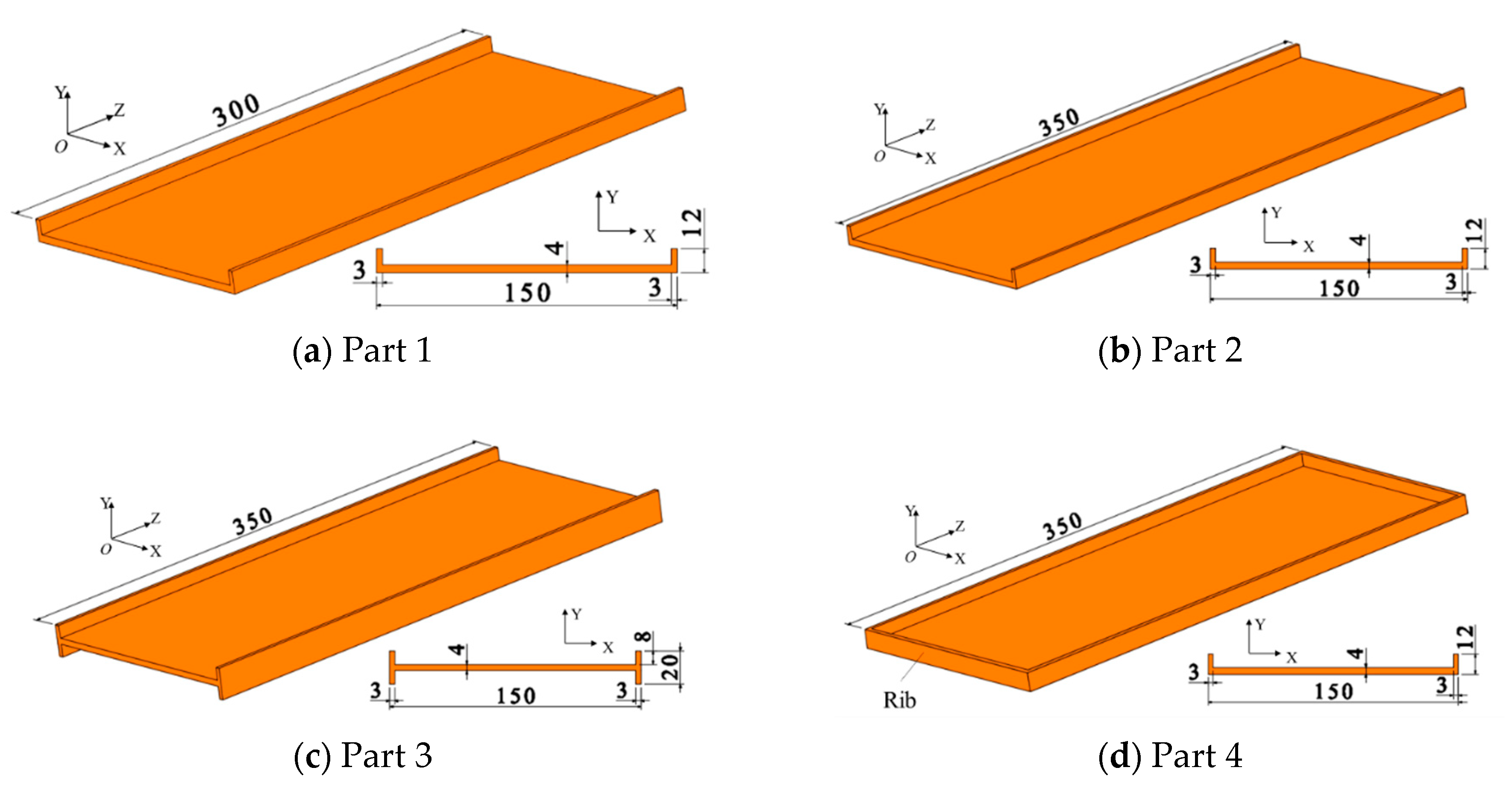

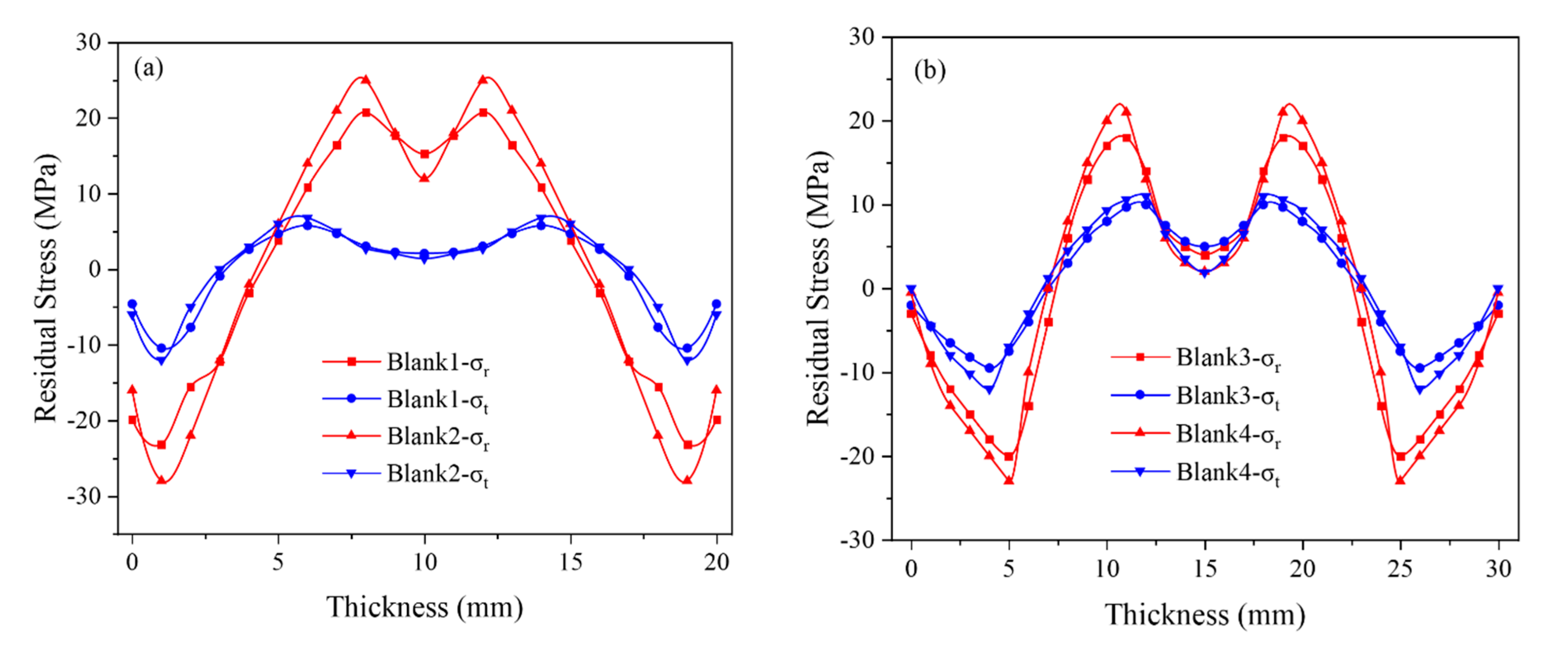
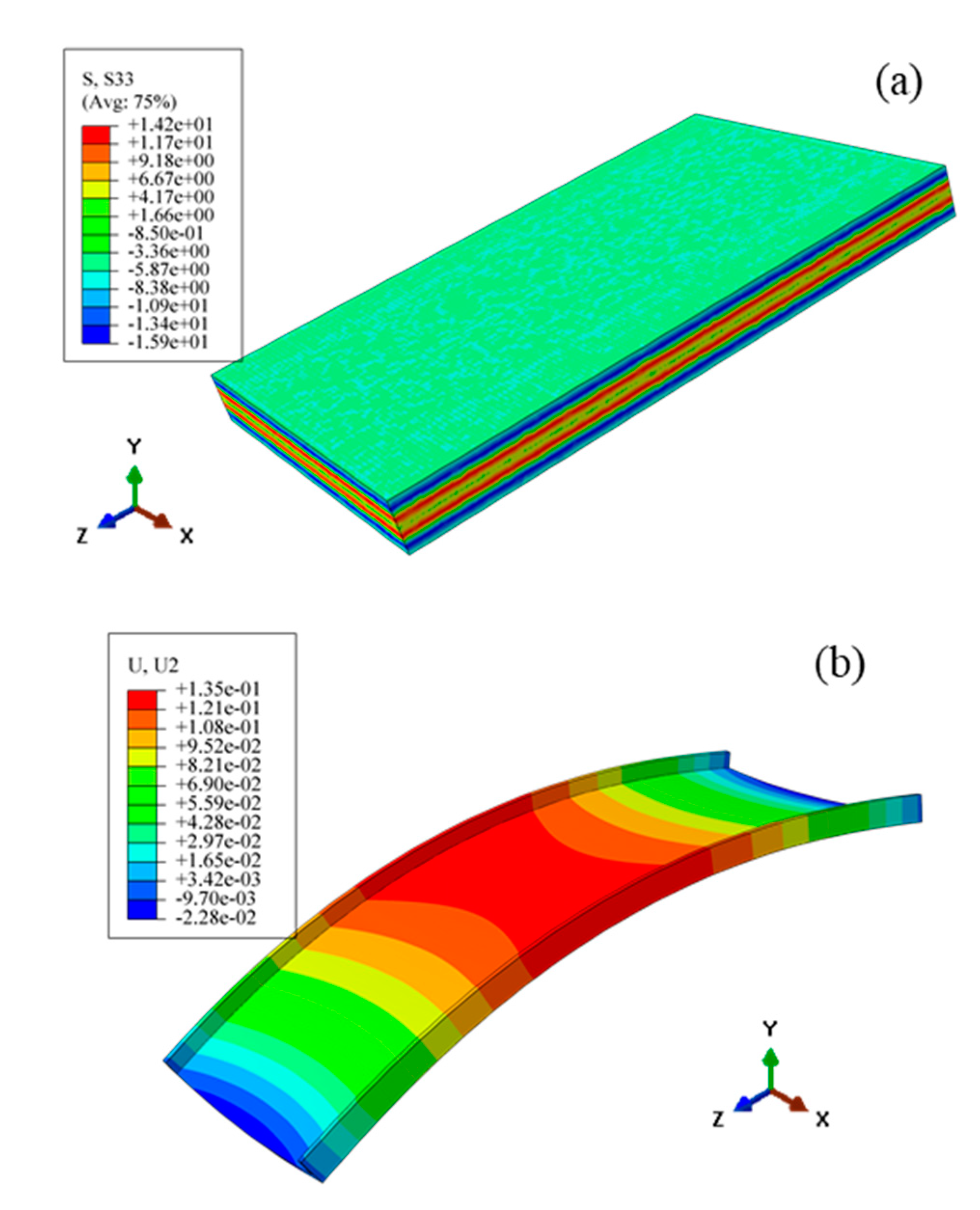
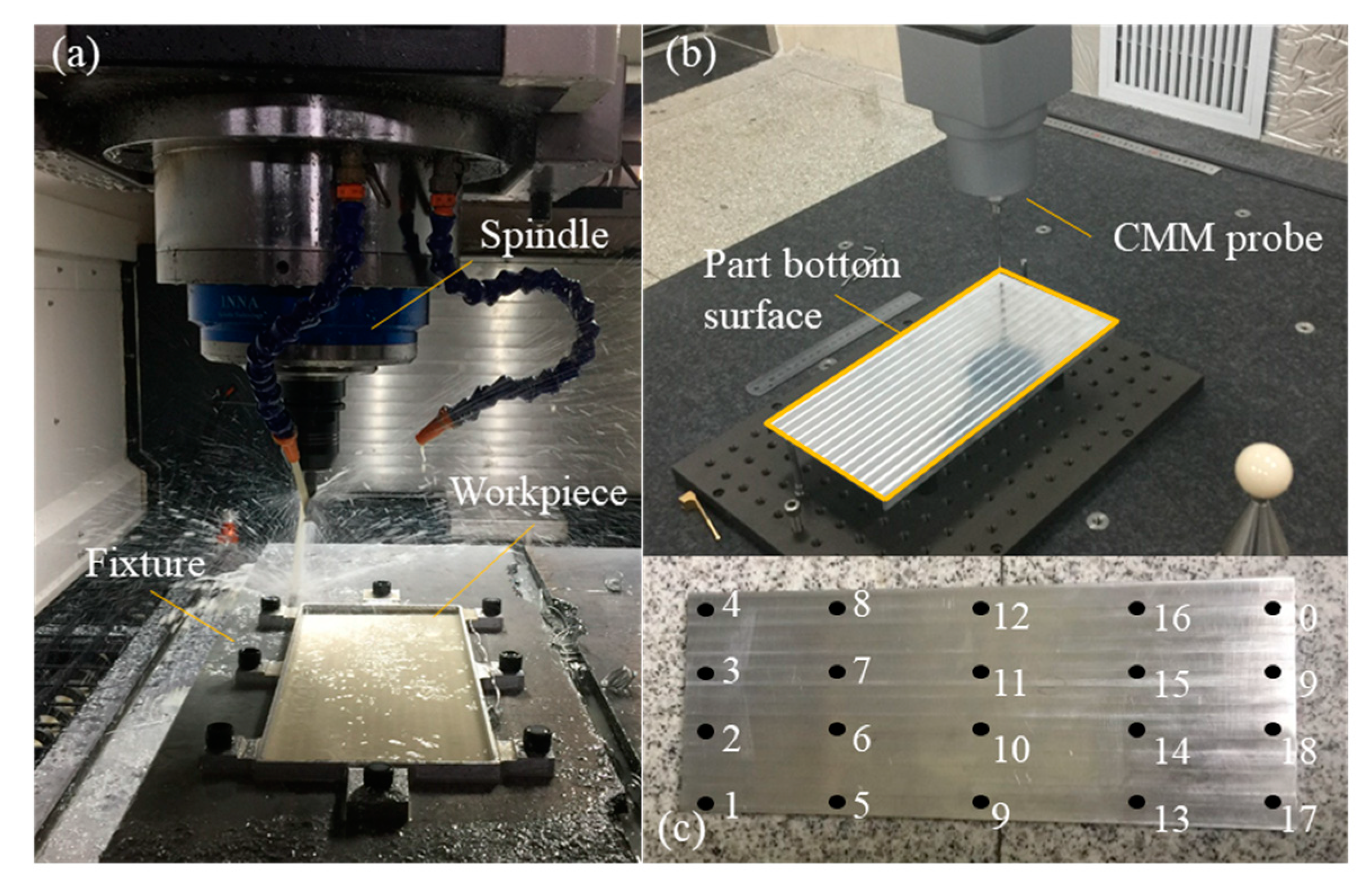
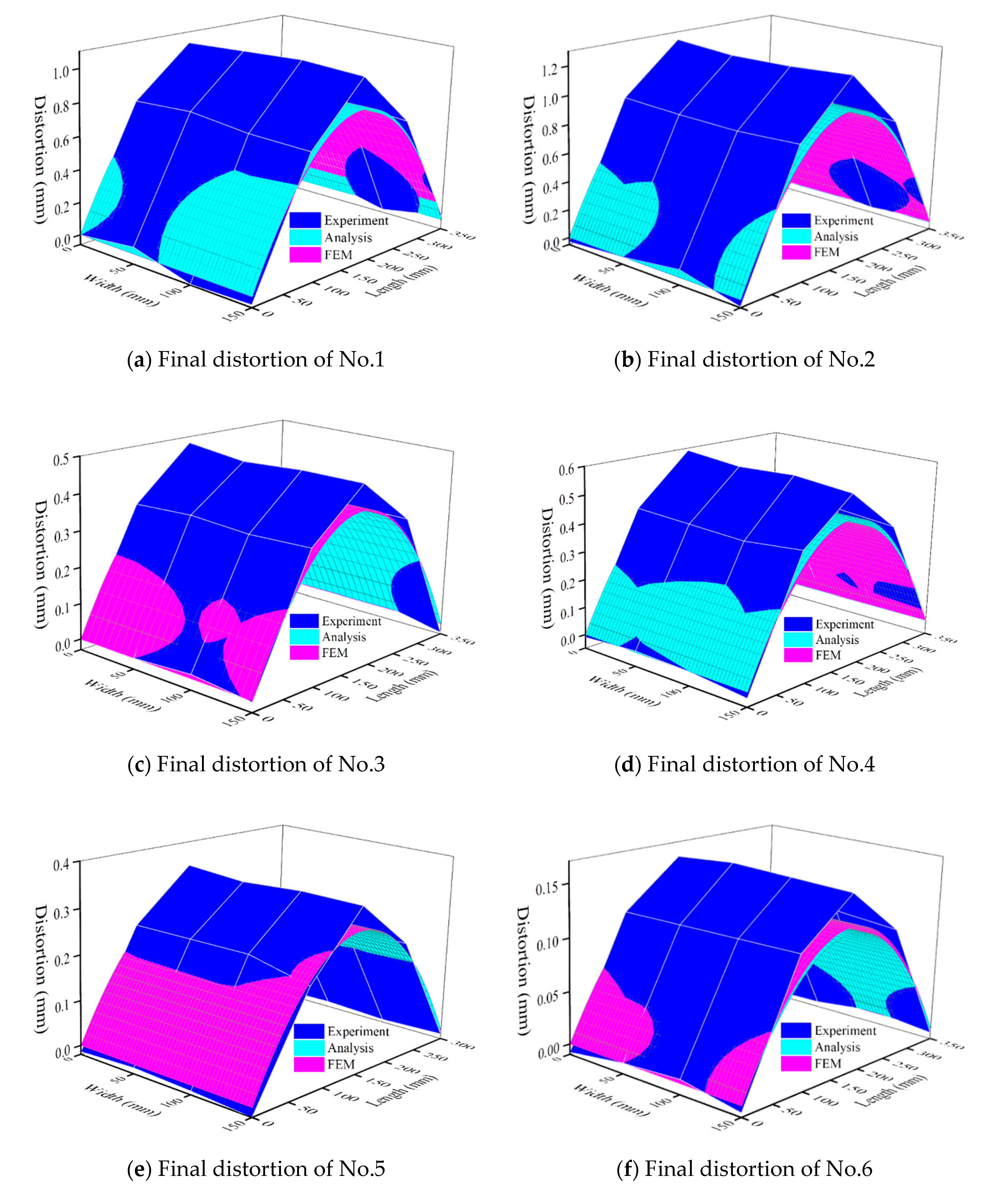
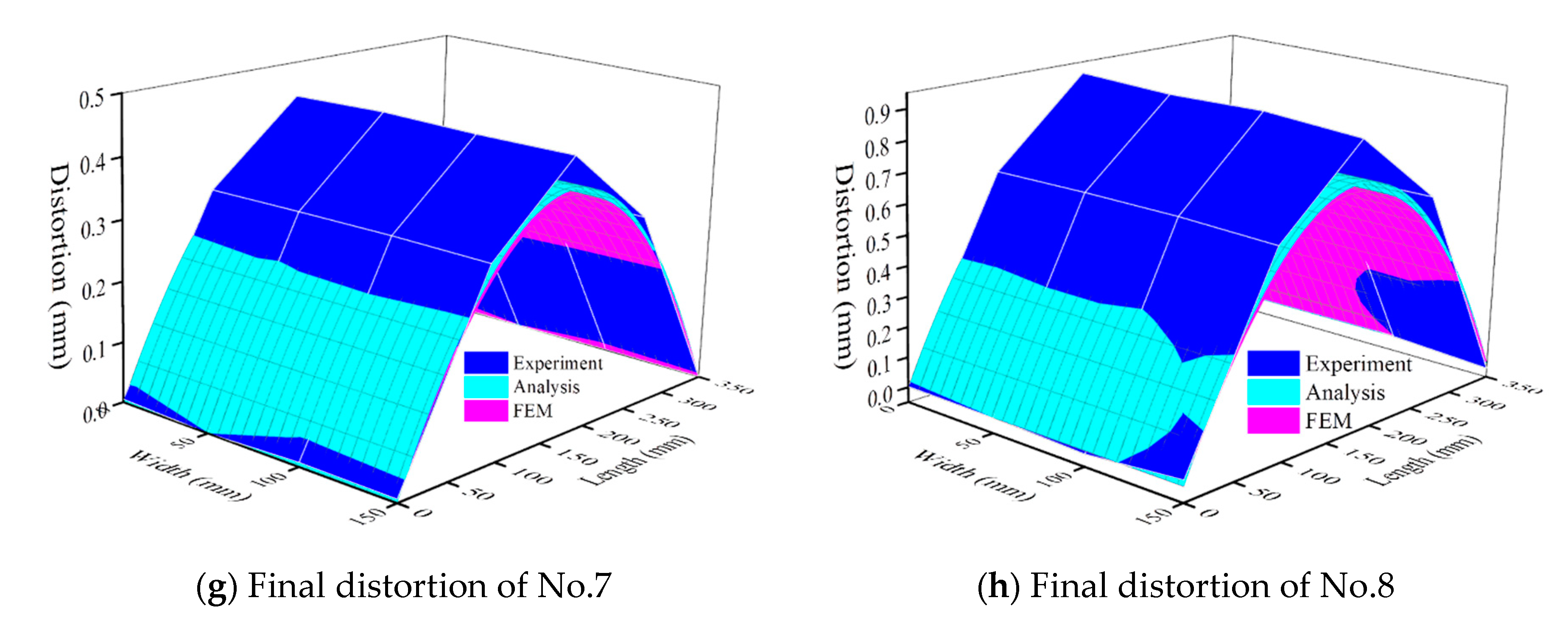

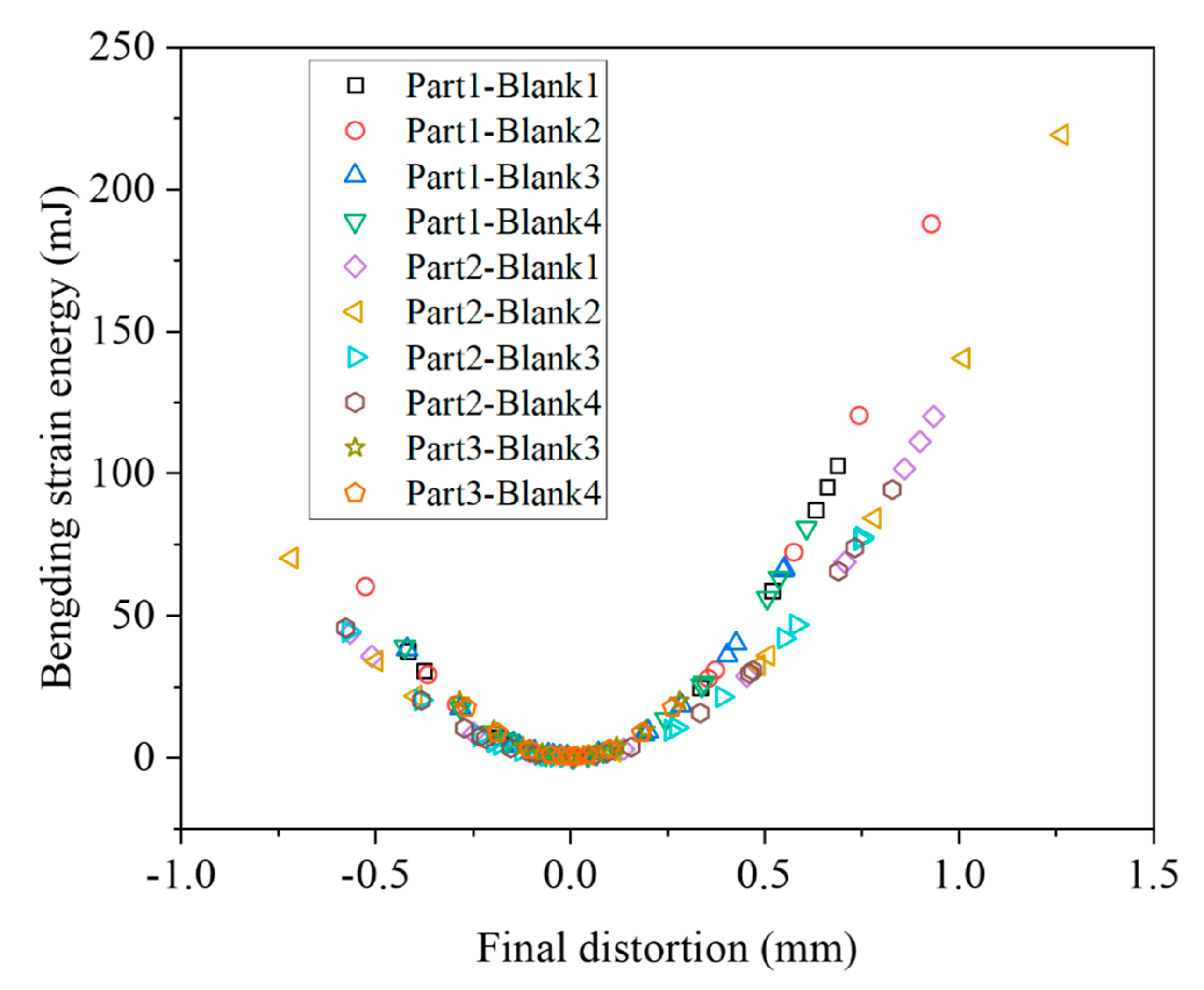
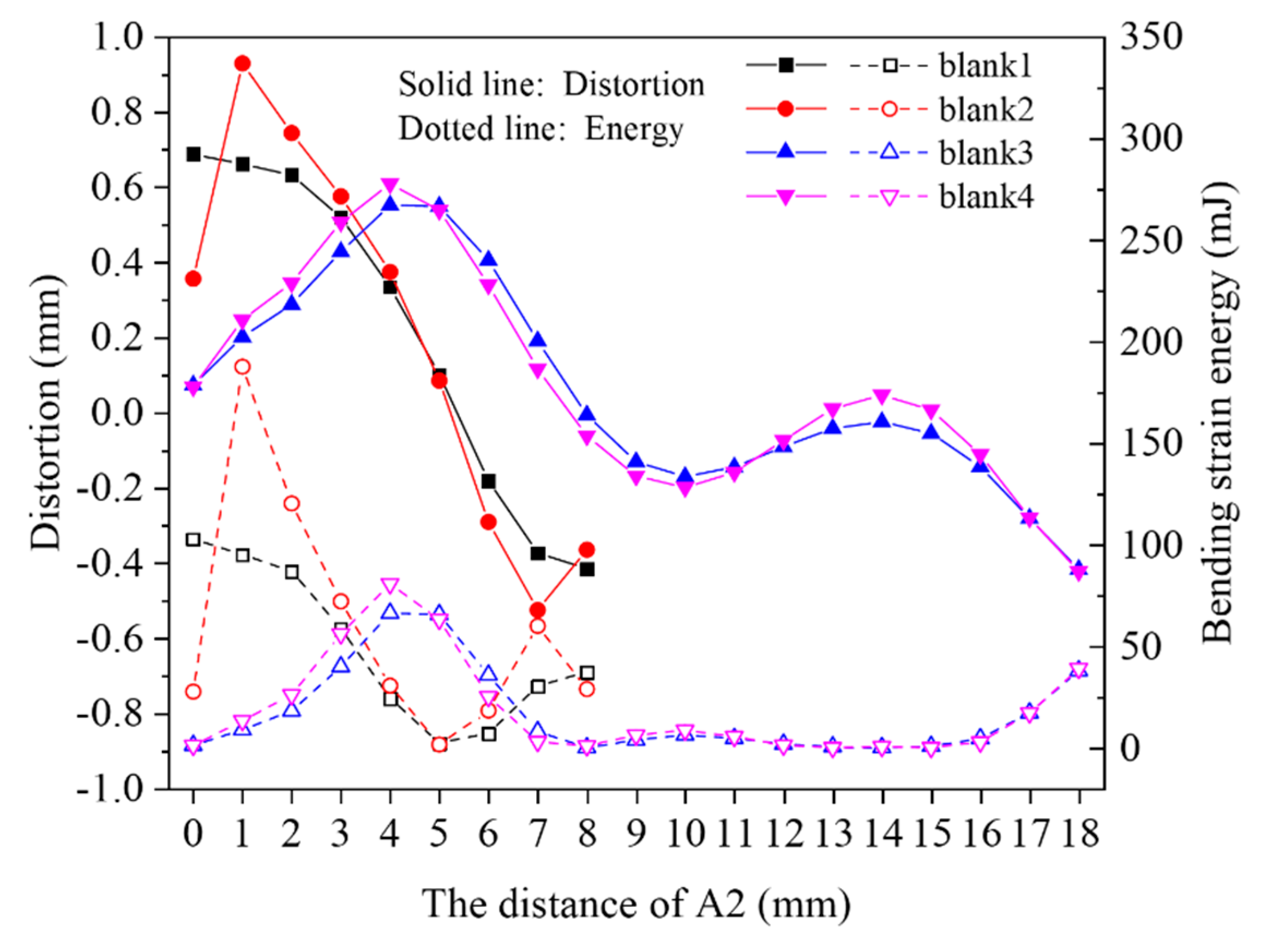

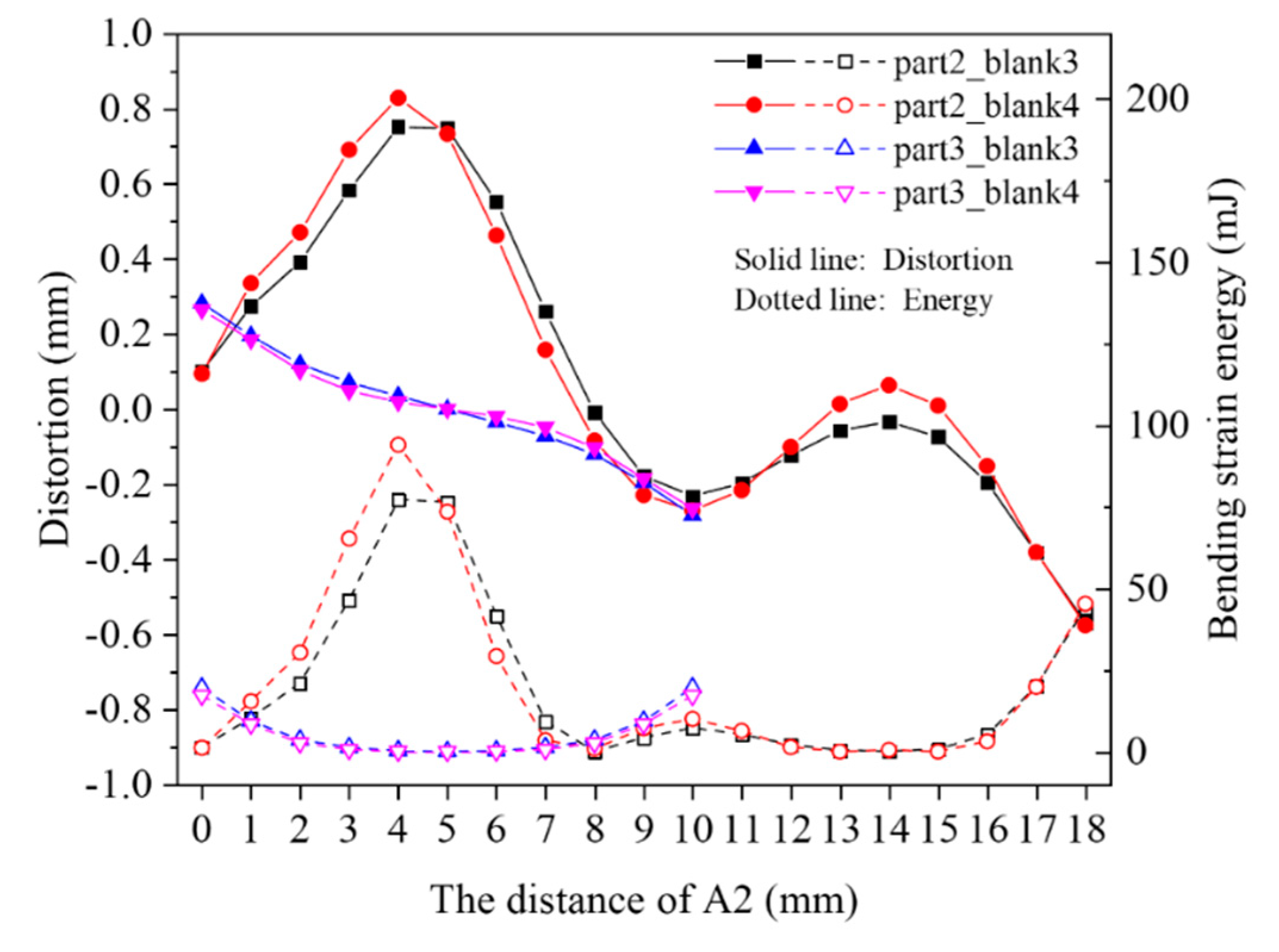
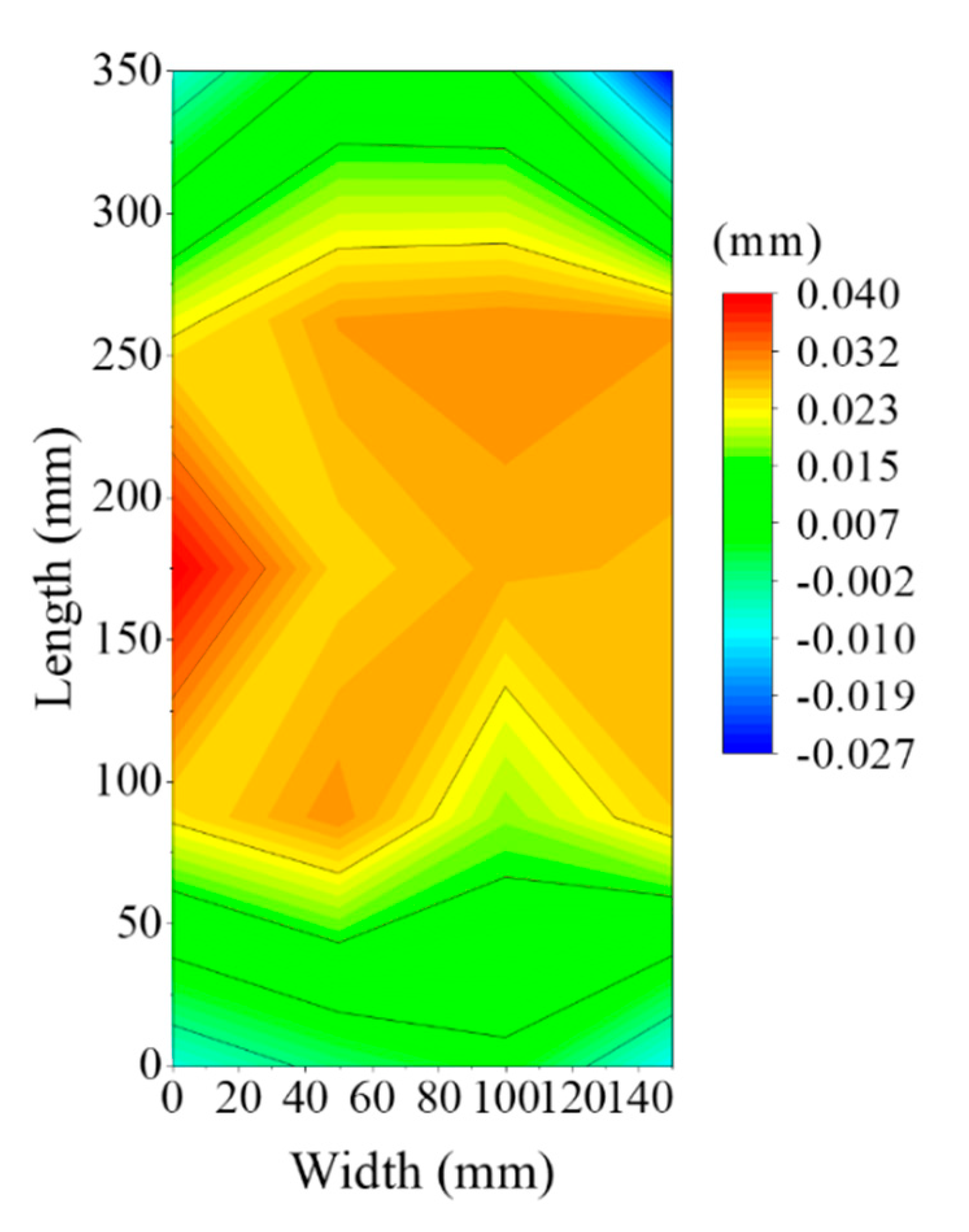


| Elastic Modulus (GPa) | Yield Strength (MPa) | Poisson’s Ratio | Density (kg/m−3) |
|---|---|---|---|
| 68.9 | 240 | 0.33 | 2.75 |
| Configuration | Numerical and Experimental Machining Plans | ||
|---|---|---|---|
| Initial Residual Stress Fluctuation | Part Geometry | Part Location | |
| No.1 | Blank 1 | Part 2 | A1 = 35 mm, A2 = 2 mm |
| No.2 | Blank 2 | Part 2 | A1 = 35 mm, A2 = 2 mm |
| No.3 | Blank 3 | Part 2 | A1 = 35 mm, A2 = 2 mm |
| No.4 | Blank 4 | Part 2 | A1 = 35 mm, A2 = 2 mm |
| No.5 | Blank 3 | Part 1 | A1 = 35 mm, A2 = 2 mm |
| No.6 | Blank 3 | Part 3 | A1 = 35 mm, A2 = 2 mm |
| No.7 | Blank 3 | Part 4 | A1 = 35 mm, A2 = 2 mm |
| No.8 | Blank 3 | Part 2 | A1 = 35 mm, A2 = 4 mm |
| Part | Blank | The Minimum Distortion Value (mm) | The Corresponding Part Location A2 (mm) |
|---|---|---|---|
| Part 2 | Blank 1 | 0.14 | 5 |
| Blank 2 | 0.12 | 5 | |
| Blank 3 | −0.01 | 8 | |
| Blank 4 | 0.01 | 15 | |
| Part 3 | Blank 3 | 0 | 5 |
| Blank 4 | 0 | 5 |
Publisher’s Note: MDPI stays neutral with regard to jurisdictional claims in published maps and institutional affiliations. |
© 2020 by the authors. Licensee MDPI, Basel, Switzerland. This article is an open access article distributed under the terms and conditions of the Creative Commons Attribution (CC BY) license (http://creativecommons.org/licenses/by/4.0/).
Share and Cite
Fan, L.; Tian, H.; Li, L.; Yang, Y.; Zhou, N.; He, N. Machining Distortion Minimization of Monolithic Aircraft Parts Based on the Energy Principle. Metals 2020, 10, 1586. https://doi.org/10.3390/met10121586
Fan L, Tian H, Li L, Yang Y, Zhou N, He N. Machining Distortion Minimization of Monolithic Aircraft Parts Based on the Energy Principle. Metals. 2020; 10(12):1586. https://doi.org/10.3390/met10121586
Chicago/Turabian StyleFan, Longxin, Hui Tian, Liang Li, Yinfei Yang, Nenggan Zhou, and Ning He. 2020. "Machining Distortion Minimization of Monolithic Aircraft Parts Based on the Energy Principle" Metals 10, no. 12: 1586. https://doi.org/10.3390/met10121586




